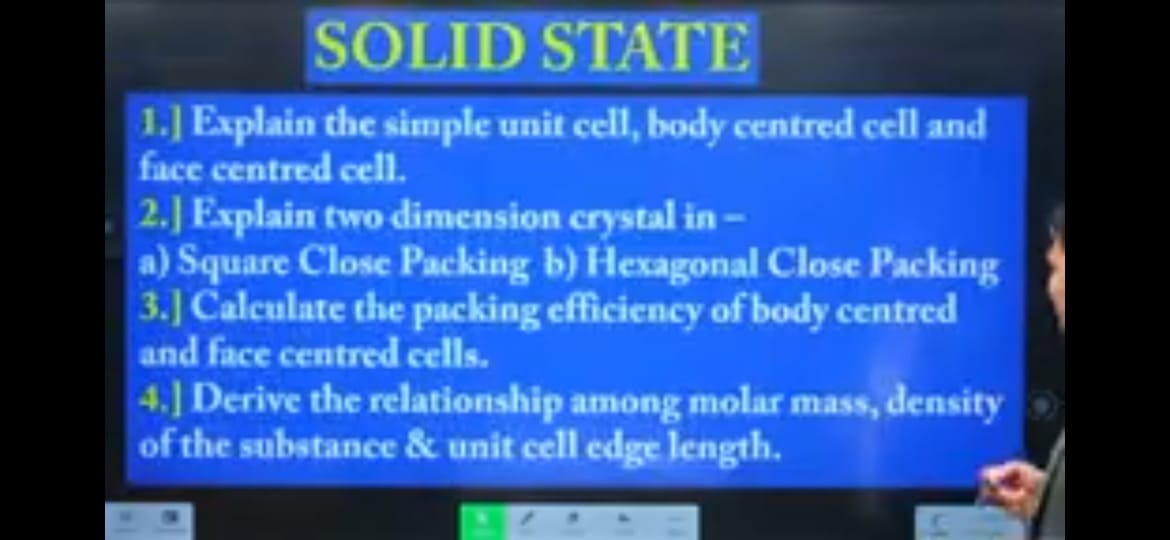1. Explain the simple unit cell, body-centered cell, and face-centered cell. 2. Explain two-dimensional crystal in: a) Square Close Packing b) Hexagonal Close Packing. 3. Calculate... 1. Explain the simple unit cell, body-centered cell, and face-centered cell. 2. Explain two-dimensional crystal in: a) Square Close Packing b) Hexagonal Close Packing. 3. Calculate the packing efficiency of body-centered and face-centered cells. 4. Derive the relationship among molar mass, density of the substance, and unit cell edge length.

Understand the Problem
The image presents four questions related to solid-state chemistry, focusing on crystal structures and their properties. The questions cover explaining unit cells, describing two-dimensional crystal packing, calculating packing efficiency, and deriving the relationship between molar mass, density, and unit cell edge length. These are standard topics in introductory solid-state chemistry courses.
Answer
1. Definitions of simple, body-centered, and face-centered unit cells. 2. Explanation of square and hexagonal close packing. 3. BCC packing efficiency: ~68%; FCC packing efficiency: ~74%. 4. Relationship: d = (Z x M) / (a^3 x N_A)
- A simple unit cell has atoms only at its corners. A body-centered cell has atoms at its corners plus one in the center of the cell. A face-centered cell has atoms at its corners plus one in the center of each face.
- a) Square close packing: atoms are arranged in square lattice, with each atom having a coordination number of 4. b) Hexagonal close packing: atoms are arranged in a hexagonal lattice, with each atom having a coordination number of 6.
- The packing efficiency of a body-centered cubic (BCC) cell is approximately 68%. The packing efficiency of a face-centered cubic (FCC) cell is approximately 74%.
- The relationship is: d = (Z x M) / (a^3 x N_A), where d is density, Z is the number of atoms per unit cell, M is molar mass, a is the edge length, and N_A is Avogadro's number.
Answer for screen readers
- A simple unit cell has atoms only at its corners. A body-centered cell has atoms at its corners plus one in the center of the cell. A face-centered cell has atoms at its corners plus one in the center of each face.
- a) Square close packing: atoms are arranged in square lattice, with each atom having a coordination number of 4. b) Hexagonal close packing: atoms are arranged in a hexagonal lattice, with each atom having a coordination number of 6.
- The packing efficiency of a body-centered cubic (BCC) cell is approximately 68%. The packing efficiency of a face-centered cubic (FCC) cell is approximately 74%.
- The relationship is: d = (Z x M) / (a^3 x N_A), where d is density, Z is the number of atoms per unit cell, M is molar mass, a is the edge length, and N_A is Avogadro's number.
More Information
Packing efficiency indicates how much space in a crystal structure is occupied by atoms.
Tips
Pay attention to how atoms are arranged in each type of cell and how this arrangement affects packing efficiency.
Sources
- 3.2: Unit Cells and Crystal Structures - Chemistry LibreTexts - chem.libretexts.org
- Closest Packed Structures - Chemistry LibreTexts - chem.libretexts.org
- Packing Efficiency of Unit Cell - GeeksforGeeks - geeksforgeeks.org
AI-generated content may contain errors. Please verify critical information